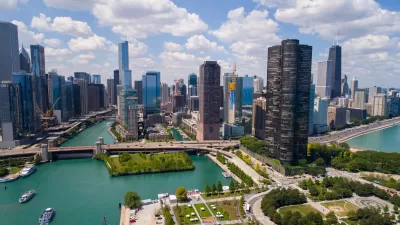The federal government set aside $5.5 billion in stimulus funding to retrofit its huge fleet of buildings. $4.5 billion is to be spent on green building projects, some of which have already been launched.
"Even with the U.S. government's large efficiency improvement, its defense, safety, and science missions require so much juice that energy per square foot still is 30 percent higher than that of the private sector. And efficiency progress appeared to be slowing. Energy improvements had to be made out of the $1 billion per year the GSA typically is budgeted for new construction or renovation of its portfolio of federally-owned buildings. Last year, a report by the U.S. Department of Energy's Federal Energy Management Program said that overall government energy intensity improvement was only 1.2 percent in 2008, less than half the goal of 3 percent per year set both by Congress and under an executive order by former President George W. Bush. "The Federal Government is not likely to meet its goals in the coming years using a business-as-usual approach," the report said."
Projects like roof retrofits and water conservation projects have already been funded, as have various solar power projects.
FULL STORY: Green Design Spree Aims to Trim U.S. Government's Big Energy Bill

Planetizen Federal Action Tracker
A weekly monitor of how Trump’s orders and actions are impacting planners and planning in America.

Maui's Vacation Rental Debate Turns Ugly
Verbal attacks, misinformation campaigns and fistfights plague a high-stakes debate to convert thousands of vacation rentals into long-term housing.

Restaurant Patios Were a Pandemic Win — Why Were They so Hard to Keep?
Social distancing requirements and changes in travel patterns prompted cities to pilot new uses for street and sidewalk space. Then it got complicated.

In California Battle of Housing vs. Environment, Housing Just Won
A new state law significantly limits the power of CEQA, an environmental review law that served as a powerful tool for blocking new development.

Boulder Eliminates Parking Minimums Citywide
Officials estimate the cost of building a single underground parking space at up to $100,000.

Orange County, Florida Adopts Largest US “Sprawl Repair” Code
The ‘Orange Code’ seeks to rectify decades of sprawl-inducing, car-oriented development.
Urban Design for Planners 1: Software Tools
This six-course series explores essential urban design concepts using open source software and equips planners with the tools they need to participate fully in the urban design process.
Planning for Universal Design
Learn the tools for implementing Universal Design in planning regulations.
Heyer Gruel & Associates PA
JM Goldson LLC
Custer County Colorado
City of Camden Redevelopment Agency
City of Astoria
Transportation Research & Education Center (TREC) at Portland State University
Jefferson Parish Government
Camden Redevelopment Agency
City of Claremont




























